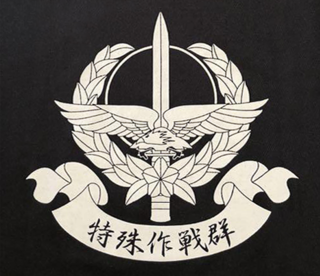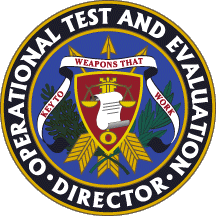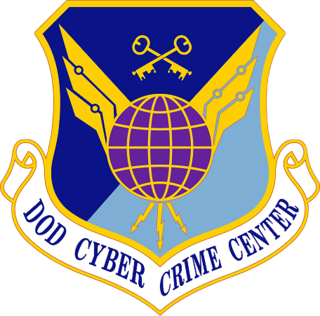
John Phillip Jumper is a retired United States Air Force general, who served as 17th Chief of Staff of the United States Air Force from September 6, 2001 to September 2, 2005. He retired from the Air Force on November 1, 2005. Jumper was succeeded as Chief of Staff by General T. Michael Moseley.

United States Joint Forces Command (USJFCOM) was a Unified Combatant Command of the United States Department of Defense. USJFCOM was a functional command that provided specific services to the military. The last commander was Army Gen. Ray Odierno. As directed by the President to identify opportunities to cut costs and rebalance priorities, Defense Secretary Robert Gates recommended that USJFCOM be disestablished and its essential functions reassigned to other unified combatant commands. Formal disestablishment occurred on 4 August 2011.
Network-centric warfare, also called network-centric operations or net-centric warfare, is a military doctrine or theory of war that seeks to translate an information advantage, enabled in part by information technology, into a competitive advantage through the robust computer networking of well informed geographically dispersed forces. It is based on ideas of marshal of USSR Nikolai Ogarkov, set out by him in early 1980s. It was pioneered by the United States Department of Defense in the 1990s.

The Global Information Grid (GIG) is a network of information transmission and processing maintained by the United States Department of Defense. More descriptively, it is a worldwide network of information transmission, of associated processes, and of personnel serving to collect, process, safeguard, transmit, and manage this information. It is an all-encompassing communications project of the United States Department of Defense. The GIG makes this immediately available to military personnel, to those responsible for military politics, and for support personnel. It includes all infrastructure, bought or loaned, of communications, electronics, informatics, and security. It is the most visible manifestation of network-centric warfare. It is the combination of technology and human activity that enables warfighters to access information on demand.

NetOps is defined as the operational framework consisting of three essential tasks, Situational Awareness (SA), and Command & Control (C2) that the Commander (CDR) of US Strategic Command (USSTRATCOM), in coordination with DoD and Global NetOps Community, employs to operate, manage and defend the Global Information Grid (GIG) to ensure information superiority for the United States.

Allied Command Transformation (ACT) is a military command of the North Atlantic Treaty Organization (NATO), formed in 2003 after restructuring.

Vice Admiral (ret.) Arthur Karl Cebrowski was a United States Navy admiral. He also who served from October 2001 to January 2005 as Director of the Office of Force Transformation in the U.S. Department of Defense. In this position, he was responsible for serving as an advocate, focal point, and catalyst for the transformation of the United States military.
John Arquilla is an American analyst and academic of international relations.
Operation Ill Wind was a three-year investigation launched in 1986 by the United States Federal Bureau of Investigation into corruption by U.S. government and military officials, and private defense contractors. Charles "Chuck" Duff was the sole Air Force Action Officer responsible for developing, coordinating and implementing Air Force actions relating to the Department of Justice's "Ill Wind" procurement fraud investigation. Government officials, private individuals and companies were eventually convicted of various crimes including nine government officials, 42 Washington consultants and 7 military contractors, as well as executives at GE, Boeing and United Technologies.
David Stephen Alberts is a former American Director of Research for the Office of the Assistant Secretary of Defense for Networks and Information Integration (NII).

Mersad is an Iranian low- to mid-range air defense system developed in 2010. It fires Shahin (Falcon) missiles which are reverse-engineered, domestically upgraded versions of the American MIM-23 Hawk surface-to-air missiles. It uses a series of domestically produced radars and electronic devices.

A Joint Task Force is a "joint" (multi-service) ad hoc military formation. The task force concept originated with the United States Navy in the 1920s and 1930s.

The Berlin Plus agreement is the short title of a comprehensive package of agreements made between NATO and the EU on 16 December 2002. These agreements were based on conclusions of NATO's 1999 Washington summit, sometimes referred to as the CJTF mechanism, and allowed the EU to draw on some of NATO's military assets in its own peacekeeping operations.

The Special Forces Group is the Japan Ground Self-Defense Force's special forces unit established on March 27, 2004 by the then Defense Agency to counter terrorist activities and deter guerrilla-style attacks on Japanese soil and to conduct military operations against guerrillas or enemy commandos. The unit is based in Camp Narashino in Funabashi, Chiba along with the 1st Airborne Brigade.

The Director, Operational Test and Evaluation (DOT&E) is the principal staff assistant and adviser to the US Secretary of Defense on operational and live fire test and evaluation activities involving U.S. Department of Defense weapons systems.

The Department of Defense Cyber Crime Center (DC3) is designated as a Federal Cyber Center by National Security Presidential Directive 54/Homeland Security Presidential Directive 23, as a Department of Defense (DoD) center of excellence for Digital and Multimedia (D/MM) forensics by DoD Directive 5505.13E, and serves as the operational focal point for the Defense Industrial Base (DIB) Cybersecurity program. DC3 operates as a Field Operating Agency (FOA) under the Inspector General of the Department of the Air Force.

United States Army Deputy Chief of Staff G-8 is part of the Department of the Army Headquarters (HQDA) and reports to the Chief of Staff of the United States Army (CSA) and Vice Chief of Staff of the United States Army (VCSA).
The Analysis of Alternatives (AoA) in the United States is a requirement of military acquisition policy, as controlled by the Office of Management and Budget (OMB) and the United States Department of Defense (DoD). It ensures that at least three feasible alternatives are analyzed prior to making costly investment decisions. The AoA establishes and benchmarks metrics for Cost, Schedule, Performance (CSP) and Risk (CSPR) depending on military "needs" derived from the Joint Capabilities Integration Development System process. It moves away from employing a single acquisition source to the exploration of multiple alternatives so agencies have a basis for funding the best possible projects in a rational, defensible manner considering risk and uncertainty.

William B. Roper Jr. is an American physicist and foreign policy strategist who served as the 13th Assistant Secretary of the Air Force for Acquisition, Technology and Logistics, overseeing procurement for the U.S. Air Force and Space Force from 2018 to 2021. Before taking office he served elsewhere within the Department of Defense as founder and director of the Strategic Capabilities Office, and prior as Ballistic Missile Defense System Architect at the Missile Defense Agency. He was also a member of the 2018 National Defense Strategy steering group. He is now a senior counselor at Pallas Advisors, a national security focused consulting group, and CEO of Volansi, a corporation specializing in delivery drones.













